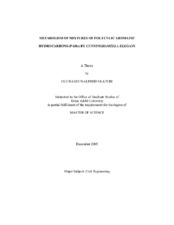| dc.contributor.advisor | Autenrieth, Robin L. | |
| dc.creator | Olatubi, Oluwaseun Alfred | |
| dc.date.accessioned | 2007-04-25T20:13:44Z | |
| dc.date.available | 2007-04-25T20:13:44Z | |
| dc.date.created | 2005-12 | |
| dc.date.issued | 2007-04-25 | |
| dc.identifier.uri | https://hdl.handle.net/1969.1/4944 | |
| dc.description.abstract | Polycyclic aromatic hydrocarbons (PAHs) are environmentally significant compounds due to the toxicity of some members. They are ubiquitous and are persistent bioaccumulative toxins(PBTs). The toxicity of PAHs represents a risk to human health, and there are varied risk assessment approaches to quantifying the risk posed by PAHs based on exposure routes and scenarios. PAHs are not carcinogenic until they are metabolically activated as the body attempts to break them down and forms reactive metabolites that bind to the DNA causing subsequent replication in the cells. Fundamental to assessing the risk posed by PAHs is understanding the metabolism of PAHs. Since exposure to PAHs is never to single PAHs, understanding what differences may occur in mixtures of PAHs gives accurate assessment of the dangers of PAHs. Understanding the dynamics of complex metabolism vis-a-vis single metabolism of PAHs and possible effects on the toxicity expression of PAHs is a necessary advancement to accurately impact and guide remediation strategies. Studies were carried out comparing the metabolism of the PAHs Phenanthrene (PHE), Flouranthene (FLA) and Benzo[a]pyrene (BAP) in single, binary and ternary mixtures by monitoring the disappearance of the parent compound. It was observed that PAH metabolism in the single PAH experiment differed from metabolism in both binary and ternary mixtures. Enzyme competition was evident in the metabolism of mixtures, changing significantly the metabolism patterns of individual PAHs. PAH structure was also seen to affect metabolism in mixtures and the possible creation of toxicity effects during mixture metabolism. PAH concentration changed over time with faster change during single PAH metabolism followed by ternary mixture metabolism and finally binary metabolism. These results affirm that substrate interactions must be considered in the risk assessment approaches to the dangers posed by exposure to PAHs. | en |
| dc.format.extent | 2456400 bytes | en |
| dc.format.medium | electronic | en |
| dc.format.mimetype | application/pdf | |
| dc.language.iso | en_US | |
| dc.publisher | Texas A&M University | |
| dc.subject | Cunninghamella elegans | en |
| dc.subject | Poly -Aromatic hydrocarbons (PAHs) | en |
| dc.title | Metabolism of mixtures of polycyclic aromatic hydrocarbons (PAHs) by Cunninghamella elegans | en |
| dc.type | Book | en |
| dc.type | Thesis | en |
| thesis.degree.department | Civil Engineering | en |
| thesis.degree.discipline | Civil Engineering | en |
| thesis.degree.grantor | Texas A&M University | en |
| thesis.degree.name | Master of Science | en |
| thesis.degree.level | Masters | en |
| dc.contributor.committeeMember | Donnelly, Kirby | |
| dc.contributor.committeeMember | Kramer, Timothy | |
| dc.type.genre | Electronic Thesis | en |
| dc.type.material | text | en |
| dc.format.digitalOrigin | born digital | en |


